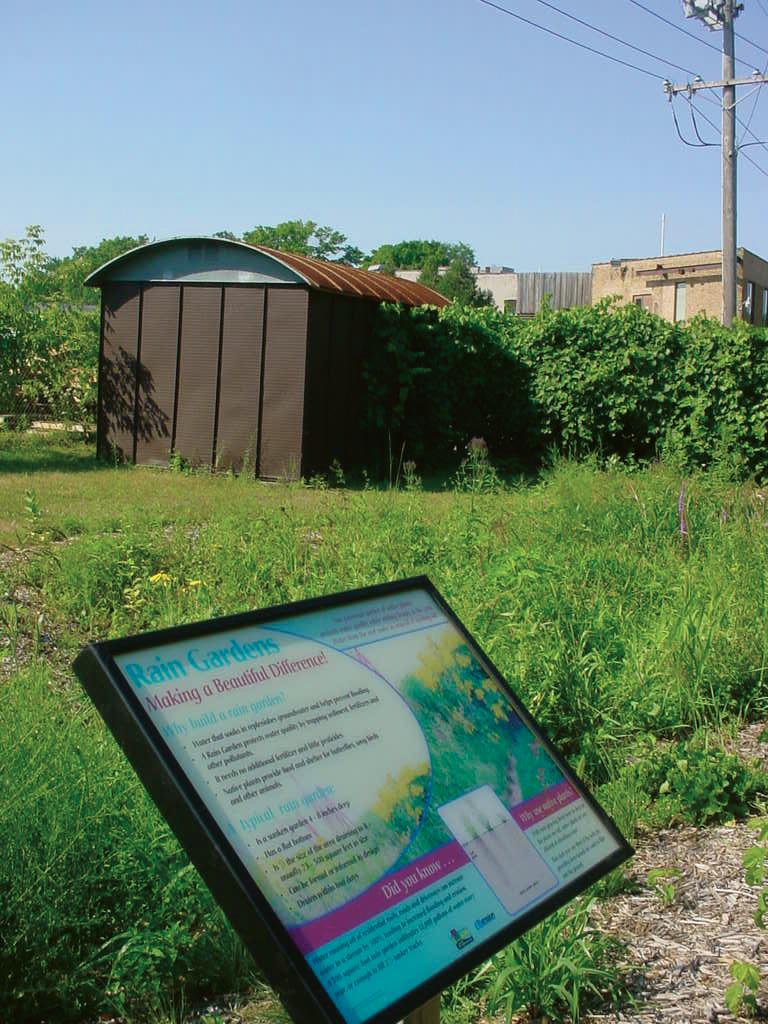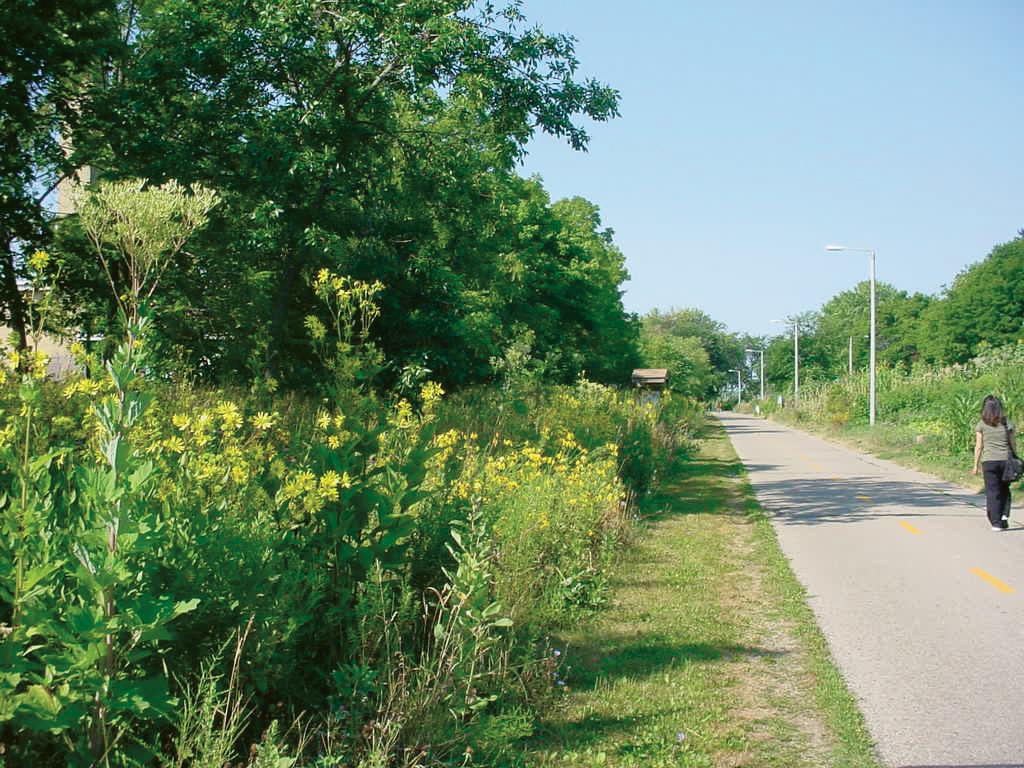As with farm settings, pollinator protection in natural areas should begin with macro-level land planning. Old meadows and overgrown pastures tend to have higher pollinator diversity than shaded areas like coniferous woodlands. Conservation efforts for pollinators should focus on areas of present and potential diversity.
Because habitat of this type is now highly fragmented, emphasis should be placed on the construction of corridors to connect otherwise separate natural areas. Pollinators use these corridors to disperse from high-population areas to low-population areas, and to aid genetic diversity by allowing mating between otherwise isolated groups.

Riparian habitat is particularly valuable, as undeveloped riparian vegetation along river corridors can provide hundreds or thousands of miles of continuous habitat. The floodplains of the upper Mississippi River for example are largely free of development, and tributary streams, where they are protected, provide vast “wildlife highways” extending deep into agricultural areas. Where these tributaries meet urban areas, pollinator habitat can be extended with public greenspaces and residential rain gardens (Figure 10.6).
Away from riparian habitat, windbreaks and hedgerows can be used to connect natural areas otherwise separated by agricultural land. In areas of the UK, rural hedgerows are actually protected by law, and are considered an essential link between the nation’s remaining woodlands. Windbreaks and hedgerows have the added benefit of reducing wind—many pollinators find it difficult to maneuver in windy locations—and hedgerow plants can often have a high pollen and nectar value to bees.
Projects like hedge planting, shoreline restorations, and construction of rainwater gardens rarely happen in a vacuum. Public involvement should be encouraged, and conservation groups and public agencies should consider pollinators in their planning.
Beyond macro-level land planning, an important stage in habitat conservation for pollinators involves plant selection. This task requires knowledge of what pollinators are native to an area, and an understanding of their lifecycle. If you are lucky, your area may already have high-quality floral sources. Often invasive species like buckthorn or reed canary grass, which crowd out other plants and reduce plant diversity, may need to be removed. In some cases an entirely new plant community may need to be installed.
Because wild pollinators are a diverse group, plant selection should also emphasize diversity (Figure 10.7). Plants of diverse flower shapes, colors, and sizes are important because different pollinators often prefer different plants. For example, bumble bees are often attracted to blue and purple flowers, while flies are often found on umbel-type flowers like those in the carrot family. Hummingbirds will be drawn to flowers with deep corollas and abundant nectar, like cardinal flower (Lobelia cardinalis), and butterflies may require specific food plants during their caterpillar stage. Ideally restored areas like “bee pastures” or “butterfly gardens” should consist of plants that have overlapping bloom times, so that flowers are present throughout the growing season. Early spring pollen sources like trees and forest ephemerals (delicate, early-blooming understory plants) are especially important for emerging bees, as are late-blooming plants for insects to build energy reserves before winter.

Whenever possible, native “local eco-type” plants should be used, since they are most likely to thrive in a given area. Just because a plant species is native to a site does not mean that it is local eco-type. Commercially produced plants for example may be grown from seed collected hundreds of miles from a planting location. These plants may have emergence patterns or pest and disease problems that differ from plants local to an area. Hybrid and ornamental plants are often not good sources of pollen and nectar, and maintained lawns usually provide no value at all unless “weedy” plants like clover, dandelions, or violets are tolerated.
Of course, if the goal of habitat restoration is to provide a wild reservoir of insects for crop pollination, plants can be selected on the basis of bloom times that occur before or after the crop bloom. Bees and other pollinators can then be expected to move into the crop during flowering and move out when flowering is finished. Through such planning the accidental poisoning of pollinators can be minimized as long as pesticides are not used on the main crop during flowering, and if drift is carefully managed/ prevented from affecting adjacent flowering plants (see sidebar).
In addition to selecting food plants, pollinators also need appropriate habitat for nesting. As with their diverse food requirements, pollinators have diverse nesting requirements. About two-thirds of our native bees nest underground as solitary individuals. Bare patches of well-drained sandy soils are particularly important to these bees. Other bees nest in hollow stems or cavities, such as those created by beetle borers in old trees. And bumble bees often nest in tall lodged grasses or abandoned rodent burrows. Dormant wasps, flies, and butterflies have equally diverse habitat requirements.
In addition to the actual nest sites, these pollinators may need construction materials to enhance their nest. Mason bees, which require mud to partition their nests, are classic example of this. For this reason, the more diverse the habitat, the more likely it is to support a diversity of pollinators. Some mixture of different locally appropriate landforms such as wetlands, forests, open meadows, sand dunes, and riparian corridors should be the goal of a diverse pollinator-friendly environment.
Manmade features can also contribute to nest site diversity. Stone walls, piles of field stone or brush, and discarded farm equipment might all be used as nesting sites. Cavity-nesting bees are often found in the walls of abandoned barns and sheds. Even hay bales are sometimes used as nest sites by bumble bees.
Finally, with any conservation project, long-term land management must be considered. Burning and mowing, two common vegetation management tactics, should be exercised with caution. Controlled burns in particular, if performed annually, can devastate populations of dormant pollinators. Performing burns infrequently, and only to small sections of the landscape at a given time may be more appropriate. Mowing should likewise be reduced, and if necessary, should be performed in the fall if possible. If weed encroachment on agricultural land is a concern, often the area directly surrounding fields can be mowed, while other areas are left undisturbed.
Natural areas should also be identified with signage restricting spraying and vehicle traffic, especially off-road vehicles in areas where ground-nesting bees are common.
For long-term preservation, pollinator habitat can be protected with conservation easements and land trusts. These types of land designations can restrict future development and limit the land uses after the owner passes away. Attorneys who specialize in estate planning and real estate issues can draft the documents necessary to establish these protections.
Habitat Restoration: A Growth Industry
Visitors to the Agrecol Corporation’s farm south of Madison, Wisconsin are often astounded at what they see—hundreds of acres of native prairie plants growing as row crops. When the big fields of plants like lance-leaved coreopsis (Coreopsis lanceolata), or purple prairie clover (Dalea purpurea) are in bloom, it is an amazing sight.
“Our goal is to produce native seed for habitat restoration,” says Agrecol’s President Mark Doudlah. “Part of that habitat restoration mission is a commitment to native pollinators. For us, as seed producers, it’s a simple equation: no bees equals no seed.”
Agrecol, whose name combines “Agriculture” and “Ecology,” presents a unique business model, synthesizing native plant production with modern tools like center-pivot irrigation and combine harvesters. Most of the seed Agrecol produces ends up in prairie restoration projects or USDA-sponsored conservation programs like the Conservation Reserve Program (CRP).
Agrecol’s farm pollination management consists of a multi-species approach, utilizing managed honey bees and leafcutter bees, as well as habitat conservation for wild bees. These conservation activities include reduced tillage in areas with high populations of ground-nesting bees, night-time pesticide applications to prevent bee poisoning, and an aggressive IPM scouting program that ensures insecticides are only applied when absolutely necessary. The end result is a state-of-the-art farm with a rich diversity of beneficial native insects.
Agrecol’s current seed catalog includes over 200 native plant species, many of which are ideal for creating pollinator habitat like bee pastures and butterfly gardens. Custom seed mixes and transplants are also available, and Agrecol even offers installation and maintenance services.
Agrecol Corporation
2918 Agriculture Drive
Madison, WI 53718
Phone: 608-226-2544
